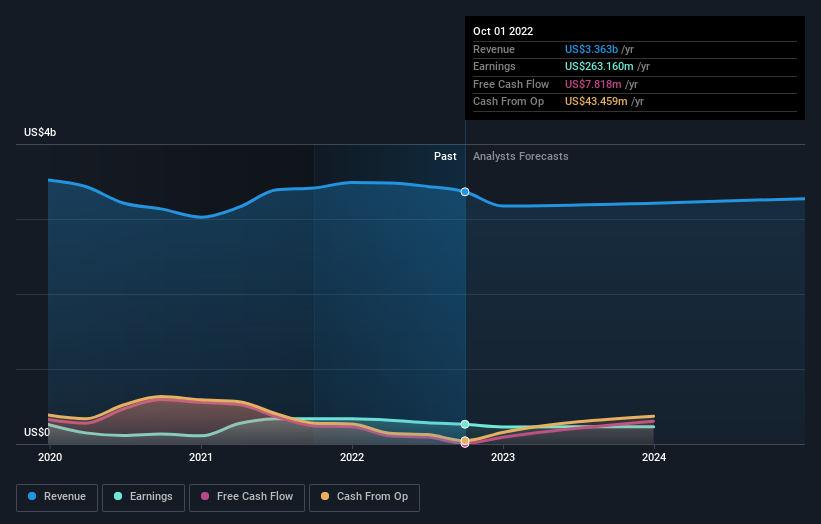Carter's, Inc. (NYSE:CRI), is not the largest company out there, but it saw a double-digit share price rise of over 10% in the past couple of months on the NYSE. As a mid-cap stock with high coverage by analysts, you could assume any recent changes in the company’s outlook is already priced into the stock. But what if there is still an opportunity to buy? Let’s take a look at Carter's’s outlook and value based on the most recent financial data to see if the opportunity still exists.
Check out our latest analysis for Carter's
What's The Opportunity In Carter's?
According to my price multiple model, which makes a comparison between the company's price-to-earnings ratio and the industry average, the stock price seems to be justfied. I’ve used the price-to-earnings ratio in this instance because there’s not enough visibility to forecast its cash flows. The stock’s ratio of 10.64x is currently trading slightly above its industry peers’ ratio of 9.84x, which means if you buy Carter's today, you’d be paying a relatively sensible price for it. And if you believe that Carter's should be trading at this level in the long run, then there should only be a fairly immaterial downside vs other industry peers. Is there another opportunity to buy low in the future? Since Carter's’s share price is quite volatile, we could potentially see it sink lower (or rise higher) in the future, giving us another chance to buy. This is based on its high beta, which is a good indicator for how much the stock moves relative to the rest of the market.
What does the future of Carter's look like?

Investors looking for growth in their portfolio may want to consider the prospects of a company before buying its shares. Buying a great company with a robust outlook at a cheap price is always a good investment, so let’s also take a look at the company's future expectations. However, with a negative profit growth of -13% expected next year, near-term growth certainly doesn’t appear to be a driver for a buy decision for Carter's. This certainty tips the risk-return scale towards higher risk.
What This Means For You
Are you a shareholder? CRI seems priced close to industry peers right now, but given the uncertainty from negative returns in the future, this could be the right time to reduce the risk in your portfolio. Is your current exposure to the stock optimal for your total portfolio? And is the opportunity cost of holding a negative-outlook stock too high? Before you make a decision on CRI, take a look at whether its fundamentals have changed.
Are you a potential investor? If you’ve been keeping tabs on CRI for a while, now may not be the most advantageous time to buy, given it is trading around industry price multiples. This means there’s less benefit from mispricing. Furthermore, the negative growth outlook increases the risk of holding the stock. However, there are also other important factors we haven’t considered today, which can help gel your views on CRI should the price fluctuate below the industry PE ratio.
In light of this, if you'd like to do more analysis on the company, it's vital to be informed of the risks involved. Every company has risks, and we've spotted 4 warning signs for Carter's (of which 3 shouldn't be ignored!) you should know about.
If you are no longer interested in Carter's, you can use our free platform to see our list of over 50 other stocks with a high growth potential.
New: AI Stock Screener & Alerts
Our new AI Stock Screener scans the market every day to uncover opportunities.
• Dividend Powerhouses (3%+ Yield)
• Undervalued Small Caps with Insider Buying
• High growth Tech and AI Companies
Or build your own from over 50 metrics.
Have feedback on this article? Concerned about the content? Get in touch with us directly. Alternatively, email editorial-team (at) simplywallst.com.
This article by Simply Wall St is general in nature. We provide commentary based on historical data and analyst forecasts only using an unbiased methodology and our articles are not intended to be financial advice. It does not constitute a recommendation to buy or sell any stock, and does not take account of your objectives, or your financial situation. We aim to bring you long-term focused analysis driven by fundamental data. Note that our analysis may not factor in the latest price-sensitive company announcements or qualitative material. Simply Wall St has no position in any stocks mentioned.
About NYSE:CRI
Carter's
Designs, sources, and markets branded childrenswear and related products under the Carter's, OshKosh, Skip Hop, Child of Mine, Just One You, Simple Joys, Little Planet, and other brands in the United States and internationally.
Flawless balance sheet average dividend payer.
Similar Companies
Market Insights
Community Narratives




